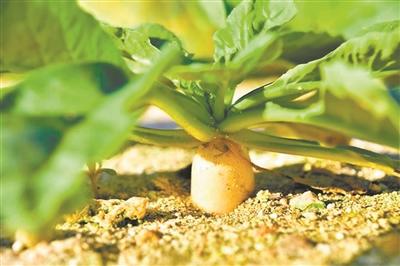Navy Xisha a Water District to technology to protect the force, efforts to crack the large-scale cultivation of green reefs problem -
the "point
②
"Fantastic! Nothing could grow on the salty and pine beach before, but now it grows green vegetables." In late May, on the white sand beach of Yongxing Island in Sansha City, a piece of planted by officers and soldiers of a naval police station in Xisha The "sand to soil" test field has enjoyed a bumper harvest: Chinese cabbage, Shanghai green, baby cabbage, garland chrysanthemum, lettuce... A green vegetable with a dripping edge is full of vitality. Song Zhile, a sergeant who came to pick vegetables, couldn't be happier: "We broke ground to grow 7 kinds of vegetables."
The leader of the marine police district told reporters: "The first successful planting of vegetables on Xisha Beach ended the history of growing vegetables on island beaches. The large-scale promotion of this technology is expected to solve the problem of eating fresh vegetables for the military and civilians stationed on the island."
The high salt, high humidity, and high temperature of the Xisha Island reef, "difficult to eat fresh vegetables" has always been a problem that puzzled the officers and soldiers of the island. From the 1970s onwards, soldiers and civilians stationed on the island basically ate fresh vegetables by ship.
"In the past, kelp, vermicelli, yuba, and pumpkin were common dishes on the Xisha dining table. Because fresh vegetables could not be eaten for a long time, officers and soldiers lacked nutritional supplements and were prone to oral ulcers."
Qiu Hua, a third-level sergeant of a Xisha garrison team who has served on Zhongjian Island for more than 20 years, introduced that in order to change the difficult environment, generations of guarding island officers and soldiers brought mud from the mainland like ants moving, and opened up on the island named after each province and city. "Palm vegetable field", growing vegetables such as water spinach, pepper, etc., but the output is limited.
In 2007, the Ministry of Science and Technology established a demonstration base for island vegetable production technology on Yongxing Island in Xisha. Subsequently, a "four-proof" greenhouse was built for Chenhang Island and other islands to prevent typhoon, sun, rain, and corrosion. In 2014, Yongxing Island introduced intelligent atomization cultivation technology, which significantly increased the output of island reef vegetables.
However, the "four-proof" greenhouse covers a large area and requires high technology, maintenance and site requirements, making it difficult to spread to the islands and reefs of Xisha.
Bai Lang is vast and connected with the sea, and Pingsha Haohao is boundless. Earlier this year, the marine police district demanded support from science and technology, and cooperated with a local university "sand to soil" scientific research team to carry out research on island and reef beach planting technology and achieved breakthroughs.
Different from the sand in the desert, the sea sand particles of the Xisha Islands and Reefs are larger, have poor adhesion, and contain a large amount of salt and alkali. The scientific research team and the officers and soldiers stationed on the island night and day, after more than 4 months of trial planting trials, successfully found the secret of the beach becoming a "good land".
In early April, officers and soldiers of the island guard of the marine police area leveled out a sandy beach at the seaside as a vegetable cultivation base. Under the guidance of the scientific research team, the officers and soldiers mixed a powdery plant fiber bonding material into the sea sand, and then fertilized by watering, "a scattered sand" can obtain the same ecological mechanical properties as natural soil, thus becoming a "fertile soil for plant growth" ".
"Half acres are harvested with more than 1,500 catties, and the output is very impressive." Song Zhile said excitedly that Xisha had plenty of sunshine. This stubble vegetable was a seed sown in early April and matured in just over a month; the next step was properly maintained , Beach planting is expected to achieve a four-year harvest.
Associate Professor Zhao Chaohua, a researcher, told reporters that this technology is easy to operate, has low cost, and has low requirements on the site and the natural environment. Not only can it solve the vegetable cultivation problem of Xisha island reef, but also hope to solve the problem of large-scale greening of island reef.
Figure ①: Happy harvest.
Figure ②: The growth is gratifying.
Author provided

